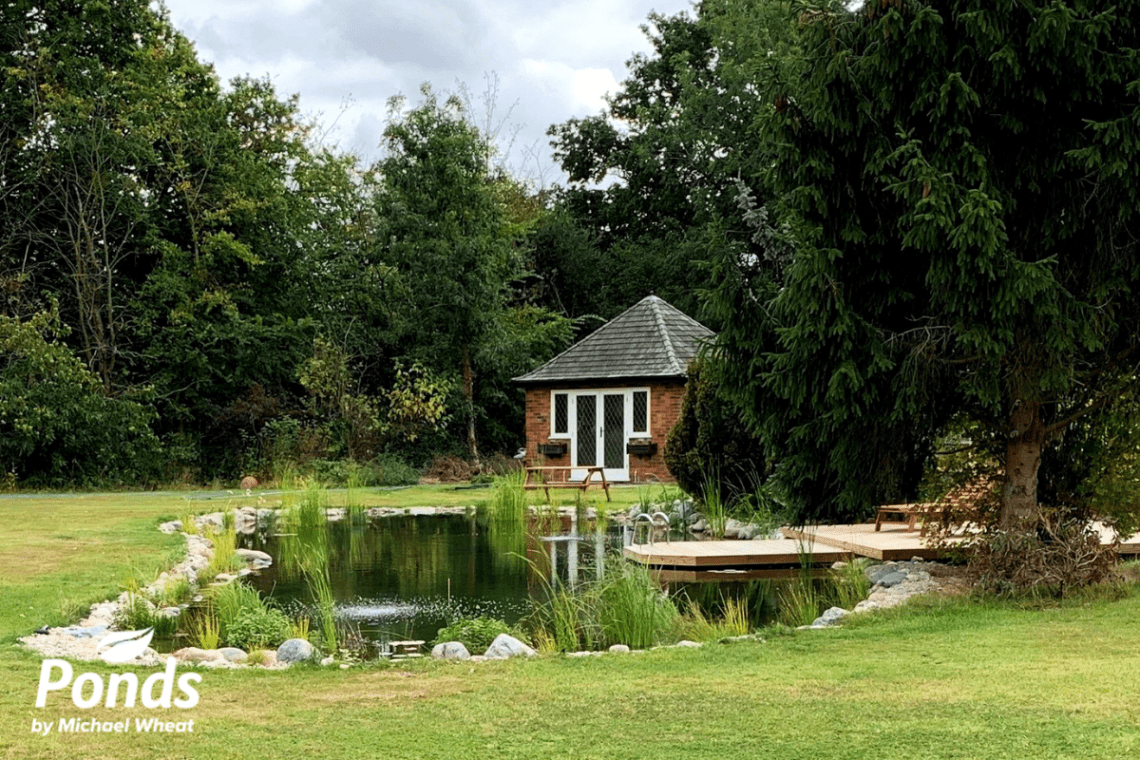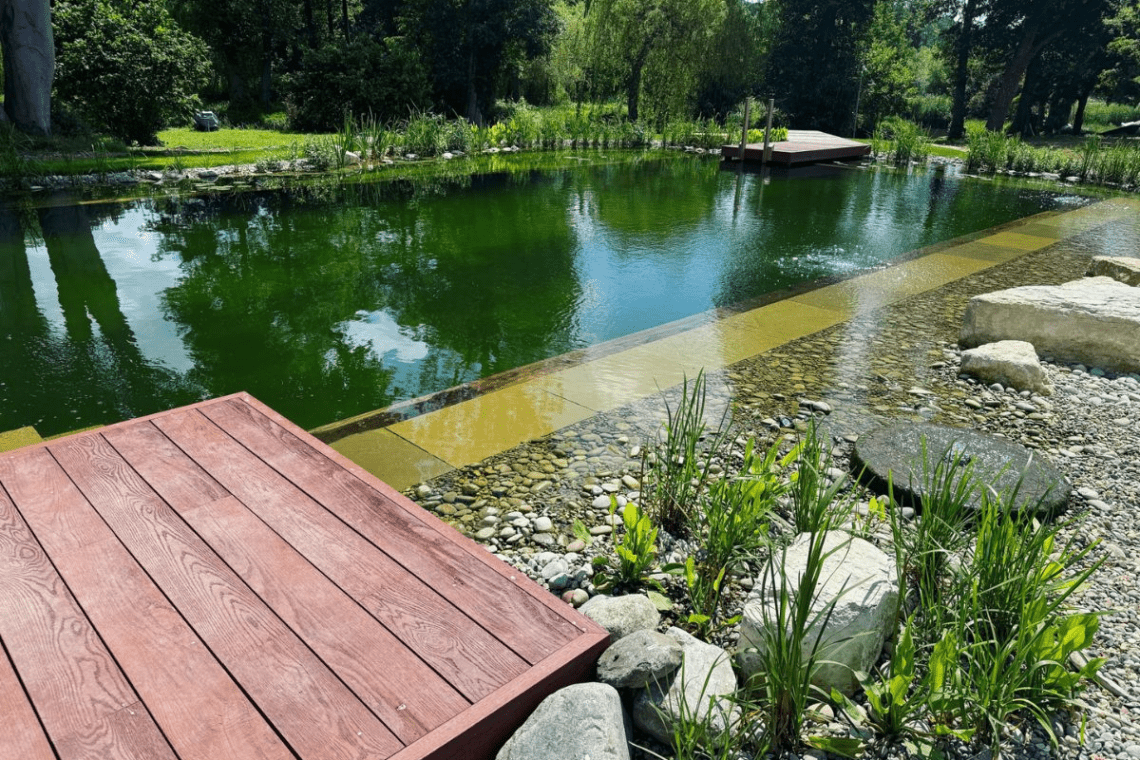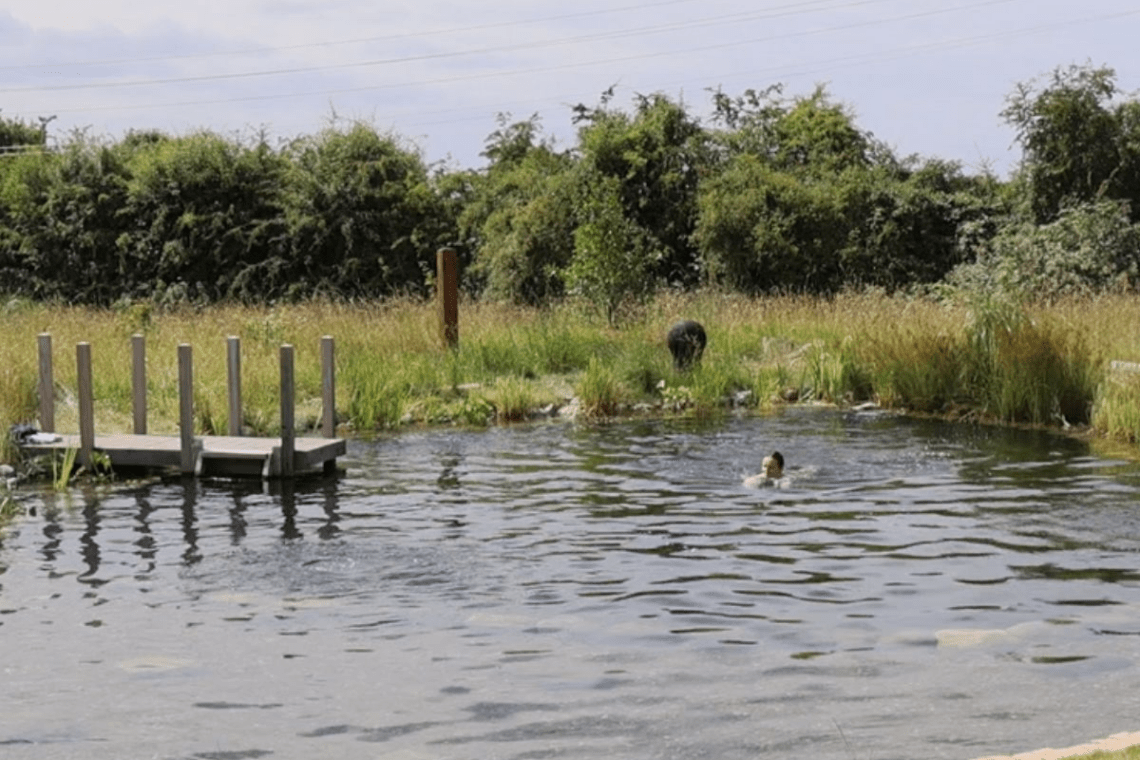Imagine stepping into your backyard and being greeted by a crystal-clear, natural swimming pond that perfectly blends with your garden’s landscape. Unlike traditional pools, swimming ponds offer a refreshing, chemical-free experience. You may be wondering, “How does a swimming pond work?”
At Ponds by Michael Wheat, we specialise in transforming these dreams into reality with our innovative designs and eco-friendly solutions.
In this blog post, we’ll explore how swimming ponds work, the benefits they bring, and why the Michael Wheat System is the gold standard for creating your personal aquatic paradise. Dive in to discover how you can enjoy the ultimate fusion of natural beauty and modern sustainability right in your own garden.
Understanding Natural Swimming Ponds

Natural swimming ponds offer an alternative to traditional swimming pools by using ecological principles to maintain clear water. These ponds combine design elements with specific technologies to create a sustainable and chemical-free swimming environment.
Concept and Design of Natural Ponds
Natural swimming ponds are designed to mimic natural bodies of water. They feature curves and irregular edges that blend seamlessly with the surrounding landscape. Various depths cater to both a swim zone and a regeneration area for plant life and water purification.
A key component of these ponds is the ecological filtration system. This system uses plants, beneficial bacteria, and other natural processes to keep the water clean. No chemicals are added, making the water safe for both humans and wildlife.
Incorporating a pond liner is essential to prevent water from seeping into the ground. The liner must be strong enough to withstand ground movement and general wear and tear. Regular maintenance involves removing plant debris and ensuring the filtration system remains effective.
The Difference Between A Swimming Pond and A Traditional Swimming Pool
A natural swimming pond differs significantly from a conventional swimming pool. One major difference is the lack of chemicals. Traditional pools rely on chlorine and other substances to maintain water quality, whereas natural pools use biological processes.
Maintenance routines are also different. Natural ponds require less frequent intervention. Regular tasks include tidying plant debris and occasional checks on the filtration system to ensure balance.
The construction standards also vary. A natural pond may need more detailed planning and construction to ensure ecological balance. This often results in a more complex and potentially costlier build, but with the benefit of a natural and sustainable swimming experience and longer-lasting results.
Swimming ponds and natural swimming pools provide a healthier alternative to traditional chlorinated pools, prioritising harmony with nature and sustainability.
Fundamentals of Eco-Friendly Water Systems

Eco-friendly water systems use natural processes and organisms to keep swimming ponds clean and safe. Key components include plants, beneficial bacteria, and natural filtration systems to maintain water quality and clarity.
Role of Plants in Water Filtration
Plants play a crucial role in filtering pond water. They absorb excess nutrients that algae would otherwise use to grow, preventing algae blooms. Additionally, the roots of aquatic plants provide surfaces for beneficial bacteria to thrive.
Different types of plants, such as reeds, water lilies, and submerged plants, contribute to a balanced ecosystem. Reeds and other tall plants are especially effective at nutrient uptake. Floating plants like water lilies provide shade, reducing algae growth.
Natural Filtration Systems and Beneficial Bacteria
Natural filtration systems are essential for maintaining a healthy swimming pond or natural pool. Beneficial bacteria are critical in breaking down organic matter such as leaves. These bacteria colonise surfaces, like plant roots. By decomposing organic material, they prevent the buildup of harmful substances that can degrade water quality.
A balance between filtration systems and bacteria helps maintain a stable and clean environment in the pond.
Maintaining Water Quality and Clarity
To keep your swimming pond’s water quality high, regular maintenance is key. Continuous water circulation via pumps and fountains prevents stagnation, which reduces the risk of unwanted bacteria and algae growth. Ensuring proper aeration in the pond also helps maintain a healthy oxygen level.
Monitoring the pond for nutrient levels and adjusting plant coverage as needed can prevent nutrient overload. Removing debris such as fallen leaves and dead plant parts regularly will also help with maintaining water clarity.
Adding UV light systems can help control algae and harmful pathogens, ensuring the water remains clean and safe for swimming. Combining these methods creates a self-sustaining, eco-friendly system that supports both aquatic life and human enjoyment.
The Michael Wheat System: Eco-Friendly and Beautiful

At Ponds by Michael Wheat, we use the one-of-a-kind Michael Wheat System, a pioneering approach to creating and maintaining natural swimming ponds, ensuring crystal-clear, chemical-free water through a unique blend of cutting-edge technology and ecological principles.
This innovative system sets itself apart by meticulously balancing aesthetics, sustainability, and functionality, offering an unparalleled swimming experience in harmony with nature.
Core Principles of the Michael Wheat System
- Natural Filtration: At the heart of the Michael Wheat System is the use of natural filtration methods. This involves a regeneration zone filled with carefully selected aquatic plants, which work together to purify the water.
- Biological Balance: Maintaining a balanced ecosystem is crucial. The system employs biological filters that support a healthy population of microorganisms. These beneficial bacteria play a vital role in decomposing organic waste, ensuring that the pond remains clear and inviting without the need for harmful chemicals.
- Aesthetic Integration: The design of each pond is tailored to seamlessly integrate with the surrounding landscape. The Michael Wheat System emphasises naturalistic features, enhancing both the beauty and functionality of the pond. This approach ensures that each swimming pond is not just a place for recreation but also a stunning garden feature.
- Sustainability: Sustainability is a key consideration in the Michael Wheat System. The use of renewable resources, energy-efficient pumps, and natural filtration methods reduces the environmental impact. The system’s design promotes biodiversity, providing habitats for various aquatic plants and animals, thus supporting local ecosystems.
- Custom Solutions: Every pond is unique, and at Ponds by Michael Wheat, we offer custom solutions tailored to individual needs and garden layouts. Whether it’s a small backyard pond or a larger swimming area, the system is adaptable, ensuring optimal performance and aesthetic appeal.
- Expert Installation and Maintenance: Professional installation is essential for the Michael Wheat System to function effectively. Our team of experts ensures that every component is installed correctly and that the pond liner is secure, preventing leaks and ensuring longevity. Regular pond maintenance services are also available to keep the pond in perfect condition year-round.
By choosing the Michael Wheat System, you are investing in a natural swimming pond that combines ecological principles with advanced technology. This system not only provides a beautiful and sustainable addition to your garden but also ensures a safe and enjoyable swimming experience for you and your family.
Final Thoughts
Incorporating a swimming pond into your garden offers a unique blend of natural beauty, sustainability, and enjoyable swimming experiences. With the Michael Wheat System, you can ensure your swimming pond remains beautiful and functional year-round, providing a safe and serene retreat for you and your family.
Ready to transform your garden? Contact Ponds by Michael Wheat today to start your journey towards creating a bespoke swimming pond that combines the best of nature and technology.
Frequently Asked Questions

1. How natural are they?
Completely natural. The plants absorb nutrients from the water. SwimPonds use no chlorine or any other chemicals. We use UV bulbs to sterilise any unwanted and potentially harmful pathogens. The mechanical pump circulates the water, a skimmer cleans leaves from the surface, and a biological filter cleans and balances the nutrients in the water. The water is unheated and is completely natural.
2. How easy are swimponds to maintain?
More accessible than a regular swimming pool, as the water doesn’t need draining, and there’s no need to add chemicals. It’s advisable to get an annual check-up, but other than that, the most one needs to do to prevent too many fallen leaves from gathering on the surface is to tidy up plant debris caught in the skimmer. The filter sponges and sieves take out any floating particles.
3. What happens in winter?
There is no need to cover it in the winter. The pruning back of dead plant matter should happen in late autumn. The filtration is left running, so the water is circulating, and nutrient levels are kept low. Sometimes the surface may freeze. This isn’t an issue; the pipework for the filtration and returns is beneath the surface.
4. Can you heat them?
Yes, but most people find that it’s not necessary.
After the sunny days of spring and summer, temperatures naturally reach up to 28˚C and stay that way until early September. Expect average temperatures to range between 19˚C and 22˚C. After a period of rain, it might drop in temperature a couple of degrees. Having a black liner installed helps to heat a pool naturally; there will be lots of shallow areas that heat up more quickly with sunlight.